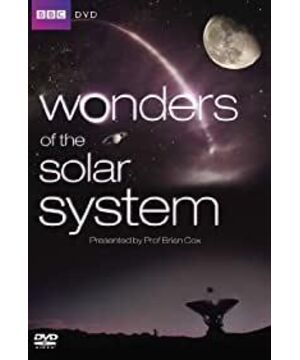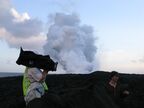Entering the pit from "Miracle of the Universe", the host is very gentle. Push.
Watching Notes:
EP01 Empire of the sun
The diameter of the sun is 400 times that of the moon, and the distance between the sun and the earth is also 400 times the distance between the earth and the moon. When the moon turns to the front of the sun, it can be blocked. The solar system has about 145-167 moons, but only the moons of Earth can produce such a wonderful total eclipse.
Mercury is the closest planet to Earth and rotates slowly, taking 176 Earth days from sunrise to sunset.
The sun's heliocentric temperature is as high as 15 million degrees Celsius.
In 1838, the British physicist John Herschel made a breakthrough in capturing the sun's beam. When the weather is clear, the energy per square meter of the sun's transmission to the earth's surface can be used for 10 100-watt light bulbs. On this basis, Herschel calculated that Total energy emitted by the sun: 40 billion gigawatts.
Earth is 150 million kilometers from the sun. Our best estimate of the age of the universe is 13.73 billion years, and the sun has been around for 5 billion years.
Molecular clouds are clouds composed of hydrogen molecules and dust. They are located between the earth and the stars of the Milky Way. They are the initial materials that form stars.
The fusion of hydrogen into helium is the source of all the sun's energy. The more sunspots, the higher the solar energy, and the solar energy will affect the changes in the earth's climate and water flow.
The Sun's atmosphere consists of a handful of charged particles, protons and electrons. The corona is hotter than the sun's surface, soaring to more than 1 million degrees Celsius, 200 times hotter than the surface.
Some of the most active particles at the outermost end of each weather layer escape outward, and the corona, the outermost layer of the sun's atmosphere, ejects nearly 7 billion tons of material particles into space every hour, collectively known as the solar wind. Although the solar wind reaching Earth is already weak, it has enough energy to blow Earth's atmosphere into outer space for a certain period of time. Earth's magnetic field radiates from the planet's rotating iron-rich core to form a huge force field called the magnetosphere, which weakens most of the stronger solar wind and turns it toward outer space. When the solar wind hits the earth's magnetic field, it deforms the magnetic field, stretching it to the back of the earth, and more and more energy enters the magnetic field. After a period of time, the energy gathers and stretches the tail until the magnetic field can't bear all the energy, and eventually the energy is charged The particles flow down the magnetic field lines in the form of being accelerated and released to the poles. These sun-infused particles enter Earth's atmosphere to create the northern lights.
Jupiter's magnetic field is the strongest in the solar system, and Jupiter's poles are permanently flooded with auroras.
The sun makes up 99% of the total mass of the solar system. The nebula formed by ice spheres is called the Oort cloud. The sun's gravity attracts the Oort cloud and surrounds the sun with a spherical surface. There is nothing outside the Oort cloud, and only sunlight leaks into the blank. Beyond the Oort cloud, there's nothing. Only sunlight escapes.
The HR diagram, predicting the history and evolution of stars.
EP02 order out of Chaos
Mercury has the fastest rotation speed, 200,000 kilometers per hour, and can complete its orbit in 88 days. Venus rotates slowly, taking longer to rotate than it takes to orbit the sun, and a day on Venus is longer than a year. Jupiter, the largest planet, takes 12 years to complete one revolution.
The law of conservation of angular momentum prevented the collapse of the early solar system, created the stability of the solar system, the nebula shrinks due to gravity, its maintained spin produces a force-balanced gravitational centripetal force and maintains a stable disc rotation, and on this disc produces all the Planets, all orbiting the sun are regular clock patterns.
In just a few million years, the clouds collapsed and formed a star system, our solar system. The planets around the sun, the journey from chaos to order begins. In just a few hundred million years, the cloud had collapsed to form a star system, our solar system. The sun surrounded by planets, and the journey from chaos into order had begun.
Cassini, launched in 1997, was the largest and most advanced spacecraft launched to the outer regions of the solar system at that time, with the purpose of studying Saturn and its rings. The images sent back show Saturn's rings are made up of thousands of individual bands and cracks, with the rings closest to Saturn moving the fastest. Each ring has hundreds of ringlets, each with billions of individual small fragments, and under Saturn's gravity, these ring grains form an extremely thin layer of ice fragments in their individual orbits. The halo is in constant motion, endlessly forming and splitting. Saturn has a total of more than 60 moons. Titan is known as the Yin-Yang moon, half of which is clean ice, the other half is covered with black dust, and has about 2/3 water, but the surface temperature is about minus 190 degrees. The giant moon Titan is larger than Mercury, has an atmosphere four times that of Earth, is rich in organic molecules, and has a chemical makeup very similar to that of early life on Earth.
Enceladus, the most reflective object in the solar system, is only 400 kilometers in size and more than a billion kilometers from Saturn. There are ice craters in the northern hemisphere and few craters in the southern hemisphere, and the surface may be newly formed. To the right of the South Pole is the tiger stripe, four parallel ditches over 130 kilometers long, about a few hundred meters deep. There is a lot of heat coming out of Antarctica. In November 2005, when the Cassini spacecraft observed that the sun was just behind Enceladus, it made one of the biggest discoveries in the outer solar system. The backlit image showed a giant geyser erupting from the South Pole, and the volcano spewed ice, which caused problems, There may be a liquid ocean beneath the surface of Enceladus, but Enceladus is too small to retain a source of heat from its core, which should come from elsewhere. Its orbit around Saturn is eccentric, and changes in its orbit cause gravitational changes, which heat up the temperature inside the moon.
There is a view that 3.6 billion years ago, the force of the resonance of Jupiter and Saturn in the orbit of the solar system caused a gravitational tide, which destroyed the orbits of all planets. Neptune was kicked to the periphery and crashed into the ring of comets surrounding the solar system. A large number of comets hit the planets, causing meteorites. Craters can be seen everywhere, and a large amount of water on Earth also comes from the impact of this "The Late Heavy Bombardment" that carries a lot of water.
The story of the solar system is the story of the creation of order out of chaos.
The planets and their moons were created by the same universal laws, the delicate interaction between gravity and angular momentum that led to the spinning patterns we see around us. The interaction of momentum resulted in the rotational patterns we see today.
EP03 the thin blue line atmosphere
The atmosphere is not a very good insulator.
Mercury, the smallest planet in the solar system, has almost no atmosphere protection, so the temperature difference is huge, from 450 degrees during the day to minus 180 degrees at night. Mercury is too small and too hot to control its own atmosphere. The bigger the planet, the stronger the gravitational pull, the easier it is to bind the atmosphere.
When the meteorite hits naked Mercury, with no atmosphere to shatter or slow it down, the meteorite hits the ground at full speed, intact. Mercury has been bombarded by numerous asteroids and comets for the past 4.6 billion years, and the entire planet's tragic history has laid its surface full of craters.
Venus, the brightest planet in the solar system, has many similarities with Earth, but the greenhouse effect of Venus' atmosphere is seriously out of control. Venus' atmosphere is overwhelmed with greenhouse gases, and the nearby sun slowly boils its oceans, pumping water vapor into the atmosphere; carbon dioxide erupts from thousands of volcanoes, and Venus gets hotter and hotter. Venus is a planet with too much atmosphere.
Mars has huge dunes and volcanoes, ice caps, dry and icy, covered with red dust, all of which are due to the fact that Mars has almost no atmosphere. A dominant factor in Mars' loss of atmosphere is interaction with the solar wind. The solar wind is a stream of superheated, charged particles that continuously moves away from the sun at more than one million kilometers per hour. This extremely powerful atomic wave is powerful enough to tear apart a planet's atmosphere. Earth's magnetosphere protects us from the solar wind. The magnetosphere is formed from Earth's molten iron core. When the core rotates, it creates a huge magnetic field that runs through the poles and wraps the Earth. This is the magnetic shield, strong enough to deflect the solar wind.
Saturn's atmosphere is thousands of kilometers thick, and huge storms roll over its entire surface. Five times further from the sun than Earth, it is a giant gas planet made of the lightest and most abundant elements in the universe (hydrogen and helium). Titan has the most Earth-like atmosphere in the solar system, rich in nitrogen and methane.
EP04 Dead or Alive
Mars has a grand canyon, known as the Valley of the Mariners, which is 8 kilometers deep and more than 3,000 kilometers long, and there is currently no sign of water. Mount Olympus on Mars is not only the tallest volcano in the solar system, but also the tallest mountain we know so far. Mars is a dead world. Planets dissipate heat through the surface into space, and smaller objects have a greater ratio of surface area to volume than larger objects, and because Mars is smaller than Earth, it loses heat faster than Earth.
All rocky planets (Earth, Mars, Venus, Mercury) form the same way, as a collapsed dust cloud 4.5 billion years ago. As the sun ignited, the solar system was born. Gradually, the body of the rock formed little by little, sinking little by little under its own gravity. All the rocky planets - Earth, Mars, Venus, Mercury- were formed in the same way. They came from a collapsing dust cloud over 4.5 billion years ago. With the ignition of the sun, our solar system was born. Little by little, the rocky bodies grew, falling together under their own gravity.
Venus, similar in size to the earth, is called the compatriot of the earth, its orbit is closer to the sun, the atmosphere is dense, the air pressure is very high, 90 times that of the earth's atmospheric pressure, and it takes 243 days to rotate once, except for the sun, it is the average surface of the solar system The temperature is the hottest (470 degrees). Venus is covered in condensed lava and has more than 50,000 volcanoes, the most in the solar system. The earth used to have too much volcanic activity, and 2/3 of the living things went extinct, but now it has recovered, and the reactions of Venus and the earth in the same volcanic activity are very different. Rain plays an important role in keeping Earth a pleasant environment and is part of the global circulatory system that keeps our atmosphere in balance, but Venus does not have liquid water because it is hotter than Earth and cannot slow down the volcanic gases entering the atmosphere, Venus ends up with a thick and The dense carbon dioxide keeps the temperature rising.
Compared to hot Venus and frozen Mars, our home is a very special boulder. Although all governed by the same general rules, our planet is neither too big nor too small, not too hot nor too cold. Compared to scorched Venus and frozen Mars, our home is a very special ball of rock. Although governed by the same universal set of rules, our planet is not too big, not too small, not too hot, not too cold.
The most distant planet in the solar system, icy Neptune, has a thick blue methane atmosphere. Uranus, the only planet with its axis lying on its axis. Jupiter is the largest planet in the solar system and is made of the same composition as the sun (hydrogen and helium, the most common elements in the universe).
Gravity is one of the fundamental forces in nature and exists in all objects. Gravity is the weakest force known, but the only force acting in the entire solar system.
Jupiter has the strongest gravitational field of all planets. Between Jupiter and Mars there is a huge amount of rocky debris that forms the asteroid belt.
The four moons of Jupiter are named after the four lovers of Zeus, the farthest Callisto, the giant Ganymede (the largest moon in the solar system), the icy Europa, and the tiny Io closest to Jupiter a lo. As a satellite, Io has no craters. The only explanation is that the surface is very young, geologically active, and volcanic activity is intense. The lava lakes on Io are enormous. Io's volcanoes are the most violent in the solar system. Away from the sun, the surface is icy and covered in frozen sulphur, thus giving it a yellow appearance. Io is not only affected by Jupiter's huge gravitational force, but also by the gravitational force of neighboring satellites, and its orbit becomes elliptical under the combined action. Weiyi has frequent volcanic activity.
EP05 Aliens
Earth is the only planet with liquid water on its surface.
The hidden outflow channels on Mars have geological features similar to the impact channels of Earth's floods, indicating that a similar major flood swept across the surface of Mars. There are caves on Mars, which means that there is an underground world, there may be water, and there is the possibility of biological existence. There is methane in the Martian atmosphere.
View more about Wonders of the Solar System reviews










